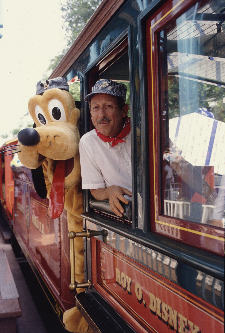Kenversations�: The Passing of Roy E. Disney
Page 1 of 2

Nobody had quite the personal insight that Roy Edward Disney had into both the Disney family and the management of The Walt Disney Company. Being the son and nephew of the founders of the company, Roy was born a little over a year after Mickey Mouse first hit the silver screen, and he grew up while his father and uncle were making their foray into feature animation.
With the opening of the Walt Disney Family Museum this year, the dichotomy between Disney as a family and The Walt Disney Company became more pronounced than ever, and now, with the passing of Roy, we�ve lost the last member of the immediate family to have an ongoing influence in company matters; someone who could invoke the founders of the company with personal, familial authority.
This matters because of the greatest assets of the company, even after all of these years, is the Disney name, and now there will be nobody with that name and a personal interest in protecting that name helping to lead the company.
Roy was often confused by the uninitiated with his father, Roy Oliver Disney, and no doubt � he had an enormous legacy looming over him. Thankfully, in recent years, his father�s importance to the Disney legacy has gotten some attention, and I would be shocked if that wasn�t the result of Roy Edward�s continued presence.
I was able to see Roy in person a few times, but I never had a conversation with the man. I was pleased when I saw some of my writings were quoted and linked by his �Save Disney� website.
Speaking of that - Roy, along with his business partner, Stanley Gold, helped save the company more than once, as has been documented in several books.
First, in the early 1980s, what was then known as Walt Disney Productions was suffering. The studio was being left in the dust creatively and financially by the likes of George Lucas, working through 20th Century Fox, and Steven Spielberg, working with Universal (and the both of them working together for Paramount). The feature animation staff was struggling to complete �The Black Cauldron�, a much-forgotten effort. The value of Disney stock falling way too low in comparison to the value of the company�s assets - a film studio; a vault full of classic features, shorts, and television shows; a stable of merchandisable characters; Disneyland in California; and Walt Disney World Resort in Florida, which included thousands of undeveloped acres. Roy, as a shareholder, was concerned about his investment. But he was also concerned because the company his father confounded was at risk. Corporate raiders experienced in buying up controlling interest in companies like Disney and selling off the parts for a tidy profit were closing in. Roy�s efforts ousted his cousin�s husband, Ron Miller (Walt Disney�s son-in-law!) from his role leading the company, and brought in Michael Eisner from Paramount. Enough investors (including the Bass Brothers) gained confidence that they�d be better off keeping the company intact and holding on to their shares that the threat to the company�s existence was averted. That was in 1984.
The second time came twenty years later. Michael Eisner had lost his apparently essential leadership partner, Frank Wells, in an accident in 1994, about the same time the �low-hanging fruit� of releasing the classics animated features on home video and adding hotel rooms to Walt Disney World Resort while raising rates were reaching the point of diminishing returns. For ten years, series of missteps culminated with Roy once again on the outside and concerned about the Company from a financial and legacy perspective. He cleverly harnessed the discontent of Disney enthusiasts and investors alike with his �Save Disney� campaign to drive Michael Eisner from the company in 2005 and regain his influence, taking the title Director Emeritus for the Board of Directors in ceremonial triumph.
